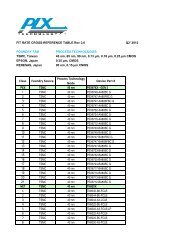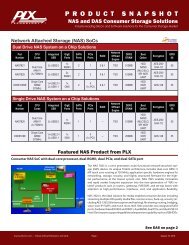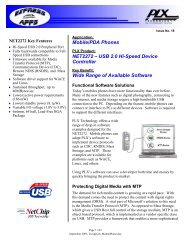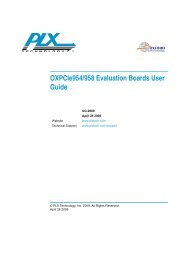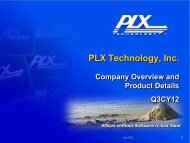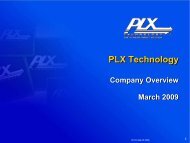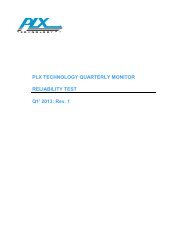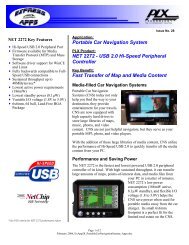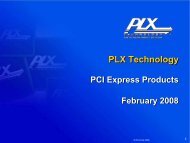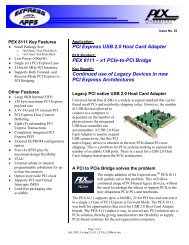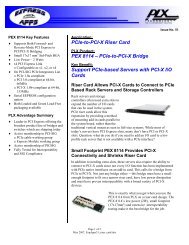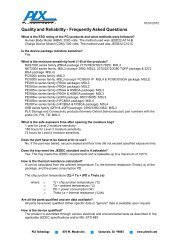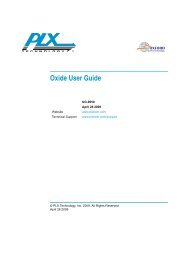the 2009 Annual Report (pdf) - PLX Technology
the 2009 Annual Report (pdf) - PLX Technology
the 2009 Annual Report (pdf) - PLX Technology
You also want an ePaper? Increase the reach of your titles
YUMPU automatically turns print PDFs into web optimized ePapers that Google loves.
Our <strong>Annual</strong> <strong>Report</strong> on Form 10-K, quarterly reports on Form 10-Q, current reports on Form 8-K and all<br />
amendments to those reports and <strong>the</strong> Proxy Statement for our <strong>Annual</strong> Meeting of Stockholders are made available,<br />
free of charge, on our website, http://www.plxtech.com, as soon as reasonably practicable after <strong>the</strong> reports have been<br />
filed with or furnished to <strong>the</strong> Securities and Exchange Commission.<br />
Industry Background<br />
The market for industry-standard interconnect has been invigorated by new state-of-<strong>the</strong>-art serial technologies.<br />
Previous parallel technologies, such as PCI, provided basic connectivity, but did not offer <strong>the</strong> necessary scalability,<br />
reliability, cost, and features for complex processing systems. As <strong>the</strong> subsystems, including <strong>the</strong> processing engines<br />
and end point devices became more powerful, <strong>the</strong> true bottleneck in <strong>the</strong> system was not <strong>the</strong> device and processor<br />
speed, but ra<strong>the</strong>r how quickly <strong>the</strong> data could be transferred to and from <strong>the</strong> different subsystems.<br />
At <strong>the</strong> same time <strong>the</strong> cost, complexity, and time-to-market problems of developing robust, high performance<br />
interconnect vehicles lead to <strong>the</strong> development of standards that provide <strong>the</strong> performance and features necessary for<br />
high performance systems, but do so at a cost point that can only be achieved through high volume standard products.<br />
These serial technologies enabled, for <strong>the</strong> first time, <strong>the</strong> ability to offer high performance, feature-rich computing<br />
solutions using off-<strong>the</strong>-shelf standards-based building blocks. The building block approach has enabled <strong>the</strong> designers<br />
of <strong>the</strong>se systems to bring <strong>the</strong>ir products to market more quickly and with a vastly lower cost of development. In<br />
addition, <strong>the</strong> software base that has built up around <strong>the</strong>se standard solutions allow <strong>the</strong> system designer to focus on<br />
<strong>the</strong>ir own added value, ra<strong>the</strong>r than recreating <strong>the</strong> basic plumbing necessary to move <strong>the</strong> data around.<br />
<strong>PLX</strong> focuses on connecting toge<strong>the</strong>r subsystems based on high volume, standard connection points. There are<br />
several aspects of this. In one aspect, <strong>the</strong> company serves a horizontal market need with its general purpose PCI<br />
Express and USB devices.<br />
PCI Express is <strong>the</strong> primary interconnection mechanism inside computing systems today. By remaining software<br />
compatible with <strong>the</strong> previous, ubiquitous parallel technology, <strong>the</strong> new switched serial PCI Express quickly became<br />
<strong>the</strong> connection of choice for <strong>the</strong> majority of devices in <strong>the</strong> industry. Since <strong>the</strong>re is a PCI Express port on almost every<br />
system building block, <strong>the</strong> least costly and highest performance approach for connecting <strong>the</strong> devices toge<strong>the</strong>r is<br />
through this interconnection pathway. However, to provide appropriate connection between subsystems in complex<br />
multi-chip systems, a switch is <strong>the</strong> most cost-effective approach. The switch is thus a fundamental building block for<br />
<strong>the</strong> system, carrying data to and from <strong>the</strong> subsystems without impeding <strong>the</strong> native performance of <strong>the</strong> underlying<br />
devices. For those few end points which do not have native PCI Express connections, <strong>PLX</strong> also provides bridges to<br />
translate <strong>the</strong> protocol.<br />
The Universal Serial Bus (USB) was designed to replace <strong>the</strong> expensive, slow, unreliable, and unscalable parallel<br />
interconnects of <strong>the</strong> time, originally to connect PCs with peripherals such as printers and external storage. Its speed<br />
has been upgraded continuously since its initial rollout, and USB has become <strong>the</strong> most popular “box-to-box”<br />
interconnect in <strong>the</strong> industry. USB has become <strong>the</strong> natural way that users upgrade <strong>the</strong>ir system with peripherals,<br />
eliminating <strong>the</strong> need to open <strong>the</strong> box and add plug-in cards.<br />
<strong>PLX</strong> has recently added a vertical market capability to its more general-purpose interconnect products. These<br />
products address <strong>the</strong> fast growing consumer/SOHO storage market. The amount of digital data that consumers need<br />
to store is increasing exponentially. Trends such as digital photography, digital video, MP3s and <strong>the</strong> on-line<br />
distribution of high-definition movies are driving increased sales of external storage devices in <strong>the</strong> consumer<br />
market. Corresponding with <strong>the</strong>se trends, demand for data-protection features such as redundant array of inexpensive<br />
disks (RAID), automatic back-up, and encryption is also growing.<br />
The Direct Attached Storage (DAS) market consists of products that allow <strong>the</strong> user to upgrade <strong>the</strong>ir storage<br />
through <strong>the</strong> USB connection on <strong>the</strong>ir PC. These systems can be configured in a variety of ways. The simplest of<br />
such systems consist of single drive upgrades to increase capacity, for backup, or to provide security encryption. By<br />
adding multiple drives to <strong>the</strong> connection, <strong>the</strong> user can make use of standards such as RAID for higher reliability (by<br />
mirroring <strong>the</strong> information on multiple disks) or higher performance (by reading and writing to multiple disks at once).<br />
3




